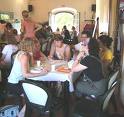
My wife and I attended a Sunday School class for the second time today. We are friends with the teacher and his wife. We know some of the couples in the class. That makes it comfortable to attend even if it meets in the Sunday School hour before worship rather than the Sunday School hour after worship where we had been attending.
Anyway, on the way out of church today, my wife said, “I know you don’t believe in tables in Sunday School, but I really liked them in our class today.” The class is arranged a little like a cafe. There are 8-10 small round tables with four chairs per table. It makes for an intimate setting that I would agree is comfortable for the twenty persons attending the class right now. But what struck me was the first half of my wife’s sentence. It made me smile. She has heard me talk about tables enough that she understands my perspective (even if she disagrees in this circumstance).
Mind you, I am not always against tables in Sunday School–just almost always! Let me share some of my reasoning against tables before I share some of the exceptions that I would make. Consider these reasons why it is best not to use tables in Sunday School:
- preschoolers and children are active and need 35 square foot per child and few churches have classrooms with an adequate amount of space for these age groups to allow for use of tables (because tables take up a lot of the space that children need);
- for most teachers and classes, using tables limits creativity–it limits the way the classroom can be arranged, how groups can be formed, and teaching methods;
- tables take up space that could allow for more people, often leading to an artificially lower average attendance than the room could accommodate without tables;
- sitting around a table can lead attenders to experience an inner circle and an outer circle–which is negative psychologically for guests and latecomers;
- if the class meets around a table, it can feel like the room is full when the table is full, potentially leading to ceasing inviting more people;
- if a class starts with tables and then attendance grows resulting in the need to remove the tables, most classes become vocally resistant; and
- tables make it harder to transition furnishings over from one age group to another (for multiple Sunday School and/or Sunday or Wednesday night activities).
Under what circumstances do I make allowance for the use of tables? Consider these circumstances:
-
in a gym where multiple (three or more) classes meet around large round tables as a result of having run out of classroom space in the rest of the church facilities (one teacher or facilitator per class per table);
-
in preschool and children’s classroom with large rooms that have adequate space for current and projected attendance at 35 square foot per child; and
-
in a fellowship hall that will be used that day following church for a church activity requiring tables (but why not ask the class to set these up after Sunday School?).
Rather than using tables, why not set chairs in horseshoes: semicircles of 5-6 chairs. In preschool/children’s classrooms, provide lapboards for projects or allow them to work in the floor (make sure the floor is kept clean; preschool/children’s space should not be carpeted either). In adult space where tables are in use, begin by removing all unused tables. Then, when attendance increases, remove tables asking the teacher to lead the class to accept their removal in order to keep growing.
What would you add or change f rom my two lists above? Don’t allow tables to prevent your class from growing or limit your creativity within the classroom. Use tables sparingly or not at all. Be revolutionary!
Leave a Reply